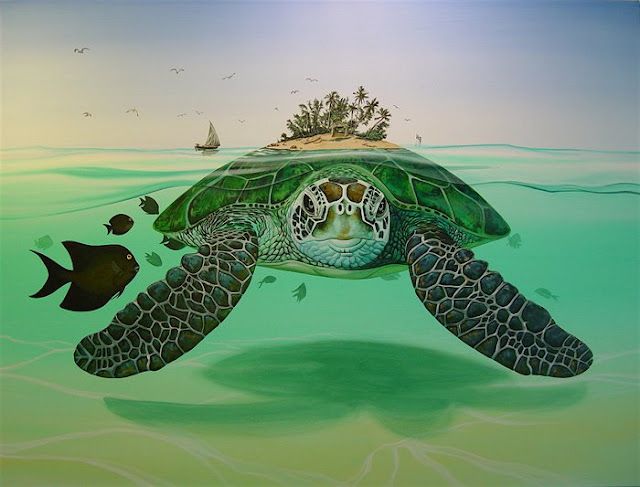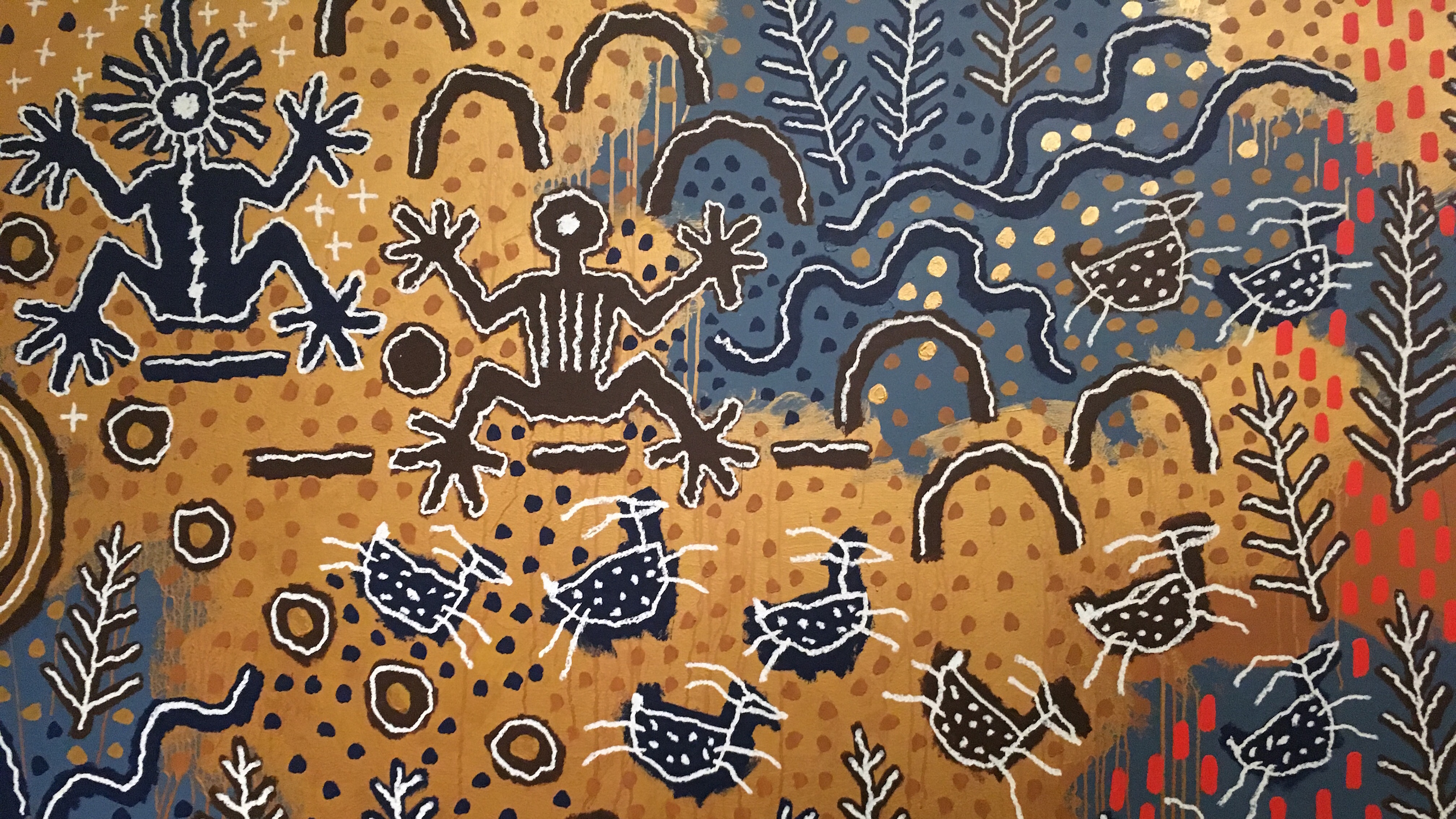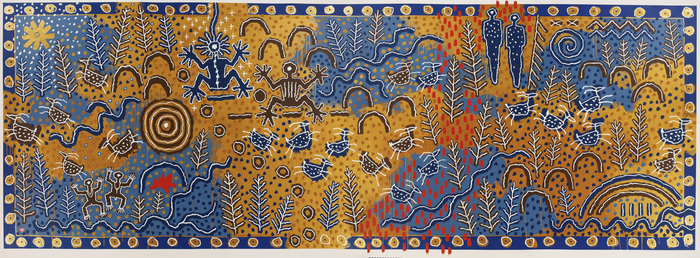Read the three indigenous people creation stories and respond to the corresponding questions. Submit your responses on Google Classroom.
New Netherlands Creation Story (ca. 1650’s)
. . . From the young Indians who frequent our settlements, and continue somewhat wild, we cannot derive any certain information of their belief on these matters; but we must have recourse to their aged men of understanding when we desire to know their belief on these important subjects.
It sometimes happens when we enter into a curious discourse with them that they ask us our opinions on the origin of man, and how they came to this country; and when we inform them in broken language of the creation of Adam, they cannot believe, or will not understand relative to their people and the negroes, on account of their great difference and the inequality of colour. According to their opinion the world was not created as described in the first and second chapters of the book of Genesis; but they say the world was before all mountains, men, and animals; that God then was with that beautiful woman, who now is with him, without knowing when or from whence they came; then was all water, or the water covered all; and they add that if there had been any eyes in being, there was nothing but water to be seen, and nothing else visible in every direction.
It happened at this period, they say, that the before mentioned beautiful woman or goddess gradually descended from heaven, even into the water, gross or corpulent like a woman who apparently would bring forth more than one child. Having gradually settled into the water, she did not go under it; but immediately at the place where she descended some land appeared under her, whereon she remained sitting. This land increased, and in time became greater and dry around the place where she sat; like one who is placed on a bar, whereon the water is three or four feet deep, which by the ebbing of the tide becomes dry land.
Thus they say and mean to be understood, it occurred with this descended goddess. And that the land became of greater extent around her, until its extent was unbounded to the sight, when vegetation appeared; and in time fruitful and unfruitful trees began to grow throughout the world as it now appears. Whether the world of which you speak originated at this time, we cannot say.
At this period of time, when those things had taken place and were accomplished, this great person was overtaken in labour and brought forth three distinct and different creatures. The first was like a deer as those now are, the second like a bear, and the third like a wolf in every respect. The woman suckled those animals to maturity, and remained a considerable time upon the earth, cohabiting with those several animals, and bringing forth at every birth more than one of a different species and appearance; from which have originated and proceeded all the human beings, animals and creatures, of every description and species, as the same now are and appear; being propagated according to nature, each in their peculiar order, as the same are in succession continued.
When all those subjects were brought to a state of perfection, and could continue, this common mother rejoiced greatly and ascended up to heaven, where she will continue to remain and dwell, enjoying pleasure, and subsist in goodness and love, which her upper Lord will afford her, for which she is particularly desirous, and God also loves her supremely above all things.
Here on the earth, in the meanwhile, the human species, and the animals after their kind, have multiplied and produced so many different creatures, and increased exceedingly, which every other thing that was created also does, as the same at present is seen. Therefore it is at this time that all mankind, wherever they be, are always born with the nature of one or the other of the aforesaid animals. They are timid and innocent like the deer; they are brave, revengeful, and just of hand, like the bear; or they are deceitful and bloodthirsty, like the wolves. Although their dispositions are apparently somewhat changed, this they attribute to the subtlety of men, who know how to conceal their wicked propensities.
- This, they say, is all they have learned from their fathers on the subject of the Creation, which has been handed down to them, and which they believe to be true . . . According to the New Netherlands story, what existed before the earth was created? What were the first three creatures created?
2. How are the personalities of these three creatures reflected by people in society?
3. Explain the significance of the main figure in this American Indian creation story and what it tells us about their culture.
Origins of Ottawa Society (ca. 1720’s)
After the creation of the earth, all the other animals withdrew into the places which each kind found most suitable for obtaining therein their pasture or their prey. When the first ones died, the Great Hare caused the birth of man from their corpses, as also from those of the fishes which were found along the shores of the rivers which he had formed in creating the land. Accordingly, some of the savages derive their origin from a bear, others from a moose, and others similarly from various kinds of animals; and before they had intercourse with the Europeans they firmly believed this, persuaded that they had their being from those kinds of creatures whose origin was as above explained. Even today [ca. 1720] that notion passes among them for undoubted truth, and if there are any of them at this time who are weaned from believing this dream, it has been only by dint of laughing at them for so ridiculous a belief. You will hear them say that their villages each bear the name of the animal which has given its people their being—as that of the crane, or the bear, or of other animals. They imagine that they were created by other divinities than those which we recognize, because we have many inventions which they do not possess, as the art of writing, shooting with a gun, making gunpowder, muskets, and other things which are used by [civilized] mankind.
Those first men who formed the human race, being scattered in different parts of the land, found out that they had minds. They beheld here and there buffaloes, elks, and deer, all kinds of birds and animals, and many rivers abounding in fish. These first men, I say, whom hunger had weakened, inspired by the Great Hare with an intuitive idea, broke off a branch from a small tree, made a cord with the fibers of the nettle, scraped the bark from a piece of a bough with a sharp stone, and armed its end with another sharp stone, to serve them as an arrow; and thus they formed a bow [and arrows] with which they killed small birds. After that, they made viretons [crossbow arrows], in order to attack the large beasts; they skinned these, and tried to eat the flesh. But as they found only the fat savory, they tried to make fire, in order to cook their meat; and, trying to get it, they took for that purpose hard wood, but without success; and [finally] they used softer wood, which yielded them fire. The skins of the animals served for their covering. As hunting is not practicable in the winter on account of the deep snows, they invented a sort of racket [snowshoe], in order to walk on this with more ease; and they constructed canoes, in order to enable them to cross the rivers.
4. According to the Ottawa, how was humankind created? Give an example of how the Ottawa learned to survive by adapting to their environment. Explain how the Ottawa viewed the role of women in their society.
5. Compare and contrast the Ottawa creation story with that of the biblical creation beliefs of the Europeans they encountered.
Sioux Creation Story (ca. 1910)
There was a world before this world, but the people in it did not know how to behave themselves or how to act human. The Creating Power was not pleased with that earlier world. He said to himself: “I will make a new world.” He had the pipe bag and the chief pipe, which he put on the pipe rack that he had made in the sacred manner. He took four dry buffalo chips, placed three of them under the three sticks, and saved the fourth one to light the pipe.
The Creating Power said to himself:“l will sing three songs, which will bring a heavy rain. Then I’ll sing a fourth song and stamp four times on the earth, and the earth will crack wide open. Water will come out of the cracks and cover the land.” When he sang the first song, it started to rain. When he sang the second, it poured. When he sang the third, the rain-swollen rivers overflowed their beds. But when he sang the fourth song and stamped on the earth, it split open in many places like a shattered gourd, and water flowed from the cracks until it covered everything.
The Creating Power floated on the sacred pipe and on his huge pipe bag. He let himself be carried by waves and wind this way and that, drifting for a long time. At last the rain stopped, and by then all the people and animals had drowned. Only Kangi, the crow, survived, though it had no place to rest and was very tired. Flying above the pipe,“Tunkasllila, Grandfather, I must rest soon”; and three times the crow asked him to make a place for it to light.
The Creating Power thought: “It’s time to unwrap the pipe and open the pipe bag.” The wrapping and the bag contained all manner of animals and birds, from which he selected four animals known for their ability to stay under water for a long time. First he sang a song and took the loon out of the bag. He commanded the loon to dive and bring up a lump of mud. The loon did dive, but it brought up nothing. “I dived and dived but couldn’t reach bottom,” the loon said. “I almost died. The water is too deep.”
The Creating Power sang a second song and took the otter out of the bag. He ordered the otter to dive and bring up some mud. The sleek otter at once dived into the water, using its strong webbed feet to go down, down, down. It was submerged for a long time, but when it finally came to the surface, it brought nothing.
Taking the beaver out of the pipe’s wrapping, the Creating Power sang a third song. He commanded the beaver to go down deep below the water and bring some mud. The beaver thrust itself into the water, using its great flat tail to propel itself downward. It stayed under water longer than the others, but when it finally came up again, it too brought nothing.
At last the Creating Power sang the fourth song and took the turtle out of the bag. The turtle is very strong. Among our people it stands for long life and endurance and the power to survive. A turtle heart is great medicine, for it keeps on beating a long time after the turtle is dead. “You must bring the mud,” the Creating Power told the turtle. It dove into the water and stayed below so long that the other three animals shouted: “The turtle is dead; it will never come up again!”
All the time, the crow was flying around and begging for a place to light.
After what seemed to be eons, the turtle broke the surface of the water and paddled to the Creating Power. “I got to the bottom!” the turtle cried. “I brought some earth!” And sure enough, its feet and claws—even the space in the cracks on its sides between its upper and lower shell—were filled with mud.
Scooping mud from the turtle’s feet and sides, the Creating Power began to sing. He sang all the while that he shaped the mud in his hands and spread it on the water to make a spot of dry land for himself. When he had sung the fourth song, there was enough land for the Creating Power and for the crow.
“Come down and rest,” said the Creating Power to the crow, and the bird was glad to.
Then the Creating Power took from his bag two long wing feathers of the eagle. He waved them over his plot of ground and commanded it to spread until it covered everything. Soon all the water was replaced by earth. “Water without earth is not good,” thought the Creating Power, “but land without water is not good either.” Feeling pity for the land, he wept for the earth and the creatures he would put upon it, and his tears became oceans, streams and lakes. “That’s better,” he thought.
Out of his pipe bag the Creating Power took all kinds of animals, birds, plants and scattered them over the land. When he stamped on the earth, they all came alive.
From the earth the Creating Power formed the shapes of men and women. He used red earth and white earth, black earth and yellow earth, and made as many as he thought would do for a start. He stamped on the earth and the shapes came alive, each taking the color of the earth out of which it was made. The Creating Power gave all of them understanding and speech and told them what tribes they belonged to.
The Creating Power said to them: “The first world I made was bad; the creatures on it were bad. So I burned it up. The second world I made was bad too, so I drowned it. This is the third world I have made. Look: I have created a rainbow for you as a sign that there will be no more Great Flood. Whenever you see a rainbow, you will know that it has stopped raining.”
The Creating Power continued: “Now, if you have learned how to behave like human beings and how to live in peace with each other and with the other living things—the two-legged, the four-legged, the man-legged, the fliers, the no-legs, the green plants of this universe—then all will be well. But if you make this world bad and ugly, then I will destroy this world too. It’s up to you.”
The Creating Power gave the people the pipe. “Live by it,” he said. He named this land the Turtle Continent because it was there that the turtle came up with the mud out of which the third world was made.
“Someday there might be a fourth world,” the Creating Power thought. Then he rested.
6. Briefly summarize the Sioux creation story. Why does the Sioux creation story include the crow, loon, otter, beaver, and turtle? What similarities does this story share with the other two stories?
7. Obviously the North American continent was separated from other cultures. Explain similarities that the indigenous stories share with other established cultures. Explain what you think contributes to these similarities.
8. From your analysis of the stories, what would say are the strengths and weaknesses of the oral tradition as historical source material? What can be learned about life and thought among indigenous peoples from a close reading of the creation stories prior to Christopher Columbus’ discovery of the new world?


